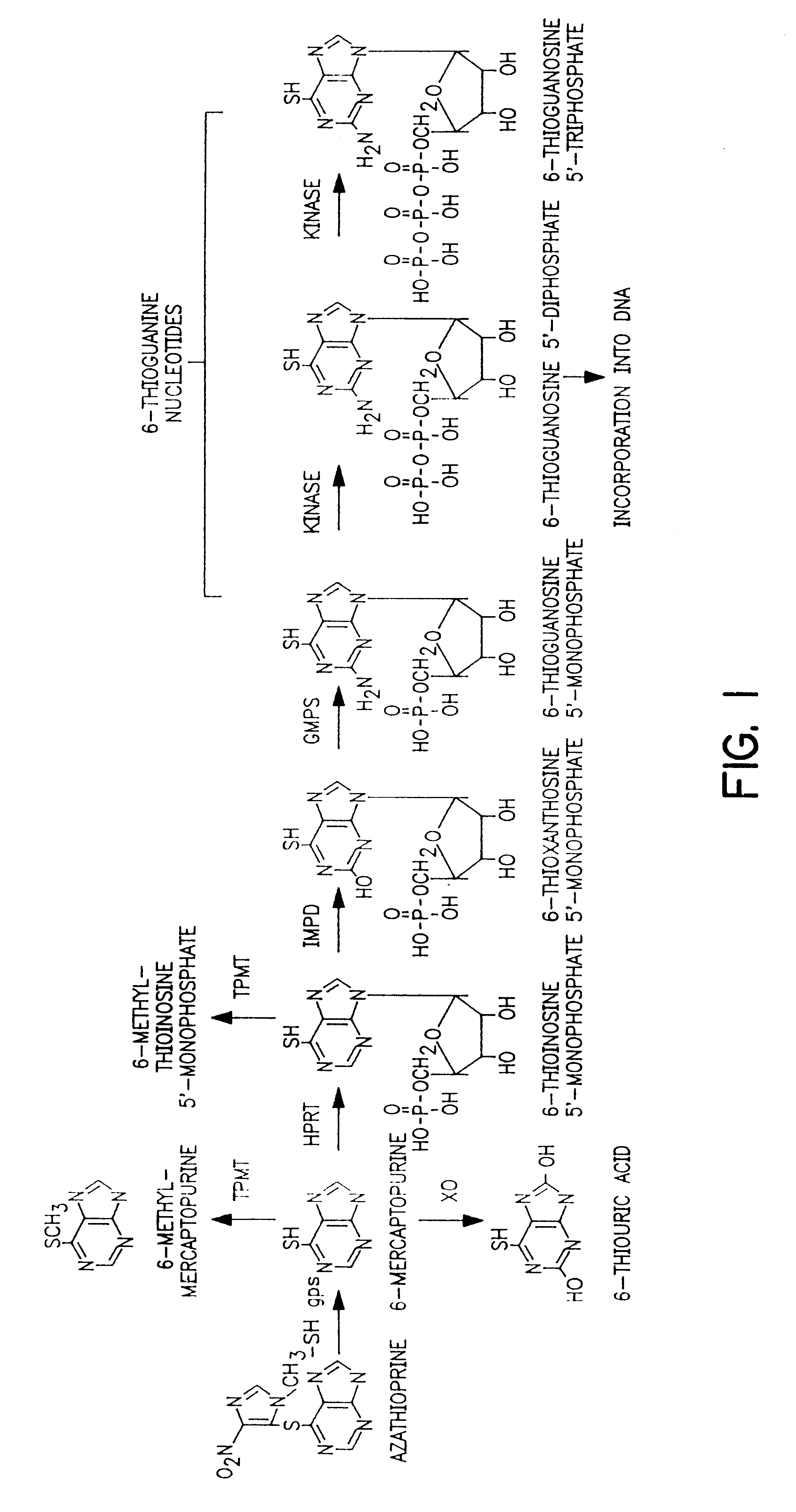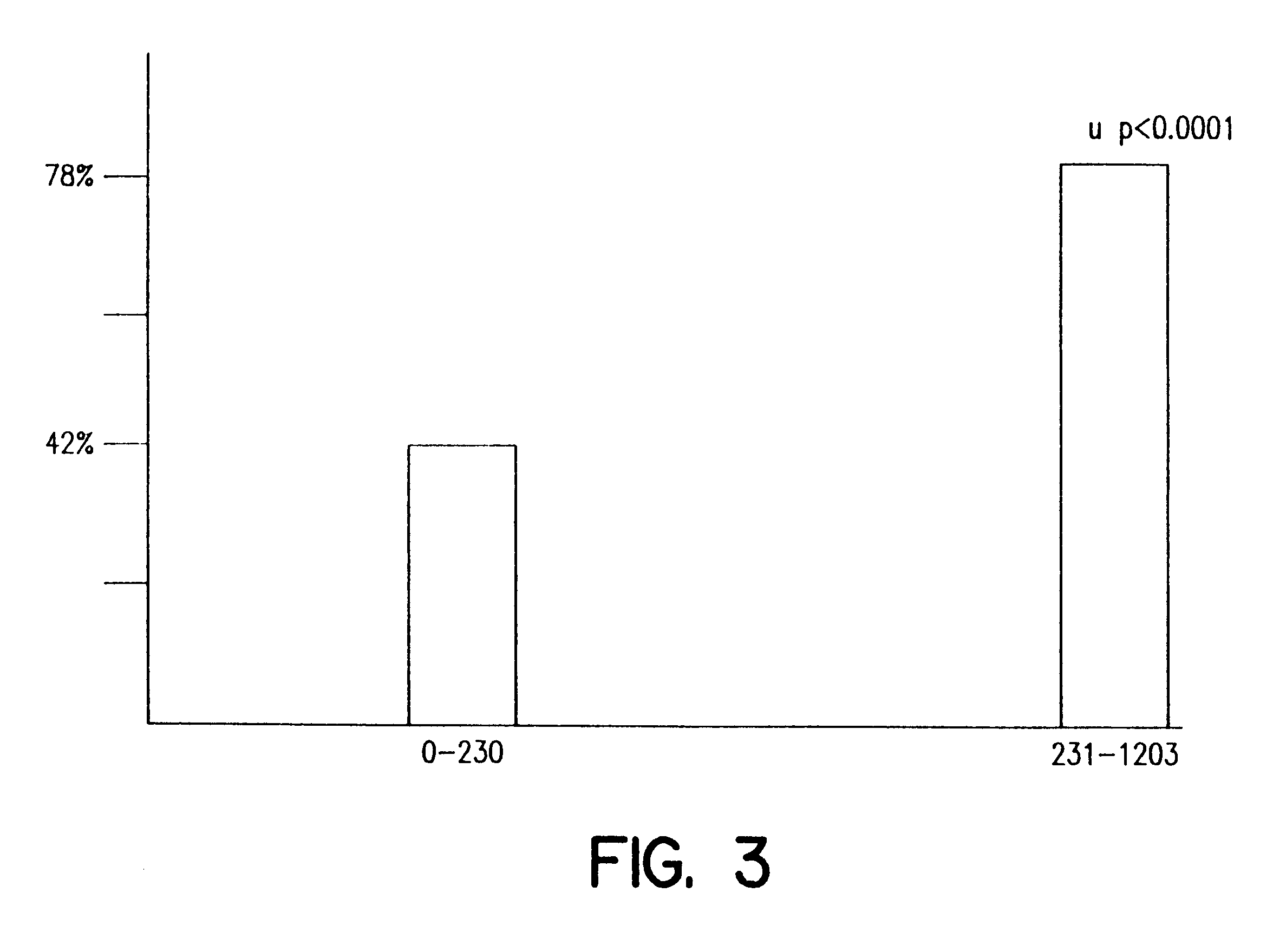Method of treating IBD/Crohn's disease and related conditions wherein drug metabolite levels in host blood cells determine subsequent dosage
a technology of host blood cells and drug metabolites, applied in the field of treating ibd/crohns disease and related conditions, can solve the problems of increased risk of intestinal cancer, potentially fatal hematopoietic toxicity, and less active patients of tpmt, and achieves the effects of reducing the risk of ibd and crohns disease, and reducing the risk of i
- Summary
- Abstract
- Description
- Claims
- Application Information
AI Technical Summary
Benefits of technology
Problems solved by technology
Method used
Image
Examples
example ii
6-Mercaptopurine Metabolite Levels Correlate with Optimal 6-MP Therapy in IBD Patients
This example describes prospective examination of the correlation of 6-MP metabolite levels with therapeutic response to 6-MP drug therapy and 6-MP drug related toxicity in IBD patients treated with 6-MP.
To obtain additional statistical data on IBD patients treated with a 6-MP drug, additional patients and samples were analyzed and combined with the data obtained in Example I. Blood was sampled at least once in 93 IBD patients followed at Sainte-Justine Hospital IBD Center, Montreal, Canada, who were administered 6-MP drug therapy for at least 4 months. The 93 patients were pediatric patients, with 80 diagnosed as having CD, 8 diagnosed as having UC, and 5 diagnosed as having indeterminate colitis (CD or UC). All but 7 patients were given AZA. The dosages were converted to 6-MP equivalents using a factor of 2.07 as described in Example I. For some patients, two or more samples were obtained and ana...
example iii
Gender and Age Differences in Metabolism of a 6-MP Drug
This example describes gender and age differences observed in pediatric patients treated with 6-MP drug therapy.
Pediatric IBD patients undergoing 6-MP drug therapy were assessed for levels of 6-MP metabolites. These patients were wild type for TPMT. Patients were assessed based on gender and age as it relates to puberty. Puberty is established at 12 years of age in girls and 14 years of age in boys.
As shown in Table 3, the 6-MMP values are much lower in boys after puberty (greater than 14 years). Since the total amount of thiometabolites is lower, this indicates that either lower doses of 6-MP are used or that there is a difference in the bioavailability of 6-MP after puberty in males.
These results demonstrate that gender and age can affect the metabolism of 6-MP in pediatric IBD patients undergoing 6-MP drug therapy.
example iv
Thiopurine Methyltransferase (TPMT) Genotyping and Responsiveness to 6-MP Drug Therapy
This example describes TPMT genotyping of IBD patients treated with 6-MP drug therapy.
The genotype of TPMT was determined in IBD patients that were responders and non responders. Genotyping of TPMT was measured essentially as described previously (Baccichet et al., Leuk. Res. 21:817-823 (1997); Zietkiewicz et al., Gene 205:161-171 (1997)). The data shown in Table 4 indicate that patients heterozygous for the TPMT mutation had significantly higher 6-TG levels compared to those patients without the mutation. All heterozygote patients were responders to 6-MP.
TPMT genotyping revealed that 8 of 93 (9%) of patients were heterozygotes. No homozygous TPMT deficient patients were detected. All 8 heterozygotes responded to 6-MP and had 6-TG levels>230 pmol / 8.times.10.sup.8 RBC.
These results demonstrate that TPMT genotyping is useful for predicting the effectiveness of 6-MP therapy in an IBD patient. Heterozy...
PUM
| Property | Measurement | Unit |
|---|---|---|
| pH | aaaaa | aaaaa |
| high pressure | aaaaa | aaaaa |
| liquid chromatography | aaaaa | aaaaa |
Abstract
Description
Claims
Application Information
 Login to View More
Login to View More - R&D
- Intellectual Property
- Life Sciences
- Materials
- Tech Scout
- Unparalleled Data Quality
- Higher Quality Content
- 60% Fewer Hallucinations
Browse by: Latest US Patents, China's latest patents, Technical Efficacy Thesaurus, Application Domain, Technology Topic, Popular Technical Reports.
© 2025 PatSnap. All rights reserved.Legal|Privacy policy|Modern Slavery Act Transparency Statement|Sitemap|About US| Contact US: help@patsnap.com



